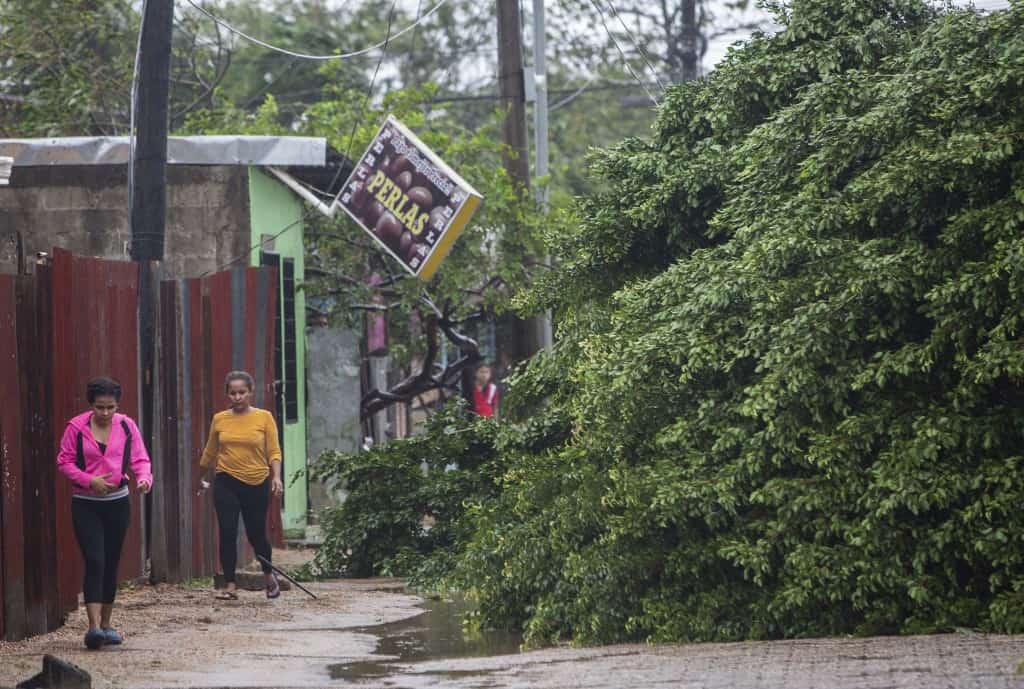Eta smashed into Nicaragua’s northern Caribbean coast as a Category 4 hurricane on Tuesday, unleashing fierce winds that tore up trees and ripped roofs off dwellings.
The hurricane, which intensified rapidly from a Category 1 storm on Monday over the warm waters of the Caribbean, hammered impoverished indigenous communities along the coast, already pummeled by high winds for the previous 10 hours.
“The edge of the eye of the storm is already beginning to touch down,” said Marcio Baca, head of Nicaragua’s meteorology institute.
Packing 140 mile per hour (225 kilometer per hour) winds, Eta tore up trees and ripped roofs off homes in Bilwi, the biggest town on the northeastern coast, also known as Puerto Cabezas.
“We spent the whole night with strong gusts of wind, accompanied by rain,” Kenny Lisby, head of a local radio station, told AFP. “It’s possible there will be quite a lot of destruction.”
Winds tore down the concrete perimeter walls of the town’s baseball stadium, and left a trail of fallen trees as dazed cattle and domestic animals wandered through the streets, AFP reporters said.
The Nicaraguan government reported no immediate fatalities, while authorities in Honduras said that a child died in a collapsed house.
The US National Hurricane Center warned the effects of Eta could be catastrophic for the region.
“Life-threatening storm surge, catastrophic winds, flash flooding, and landslides expected across portions of Central America,” it said, including Jamaica, southeast Mexico, El Salvador, southern Haiti and the Cayman Islands.
“The center of Eta is expected to make landfall along the coast of Nicaragua within the hurricane warning area this afternoon,” the NHC said Tuesday.
Eta is forecast to move inland over northern Nicaragua and central Honduras through Wednesday and into Thursday.
Devastation expected
At the request of the government, the UN World Food Programme said it had sent 80 metric tons of food for distribution in the region.
“We joined forces to respond immediately, pre-positioning food for the people affected. Our staff have also deployed to the hurricane impacted area so as to support the national response with logistics and telecommunications support,” said Giorgia Testolin, WFP Representative in Nicaragua.
Some 100,000 people live in Bilwi and adjacent communities along the coast, mostly inhabited by indigenous Miskito and Mayagna people who are among the poorest in Nicaragua.
The hurricane is likely to have a devastating effect on their main livelihoods of fishing and agriculture, the UN agency said.
As the surface layer of oceans warm due to climate change, hurricanes are becoming more powerful and carry more water, posing an increasing threat to the world’s coastal communities, scientists say.
Storm surges amplified by rising seas can be especially devastating.
In the coastal community of Prinzapolka, winds tore the zinc roofs from simple wood-framed dwellings, local teacher Kevin Lacwood told AFP.
The government said it had evacuated 20,000 people from the coast to shelters inland.
The governments in Nicaragua, with more than six million people, and neighboring Honduras, with more than nine million, have warned populations in the path of the hurricane to prepare as best they can.
In Honduras, a small girl died when a house collapsed in the El Carmen slum in northern San Pedro Sula, the country’s second largest city, where Eta caused flooding that forced hundreds of people to evacuate their homes, relief agencies said.
Heavy rains lashed the Caribbean ports of La Ceiba and Tela, where authorities evacuated more than 100 people, as water levels rose dangerously in local rivers.






